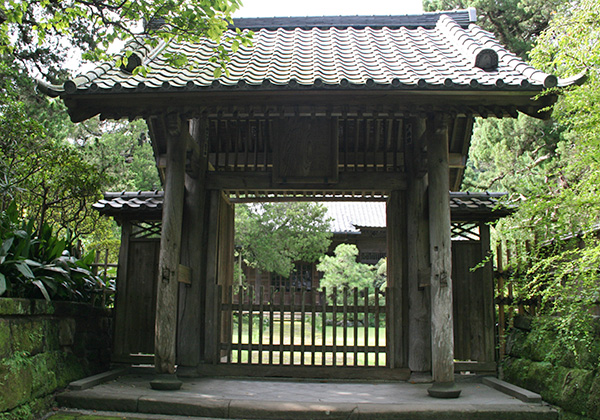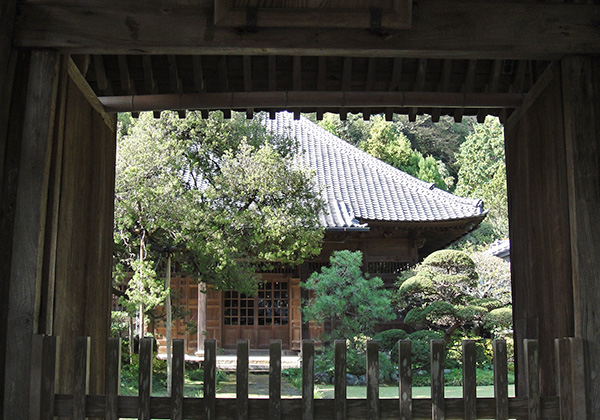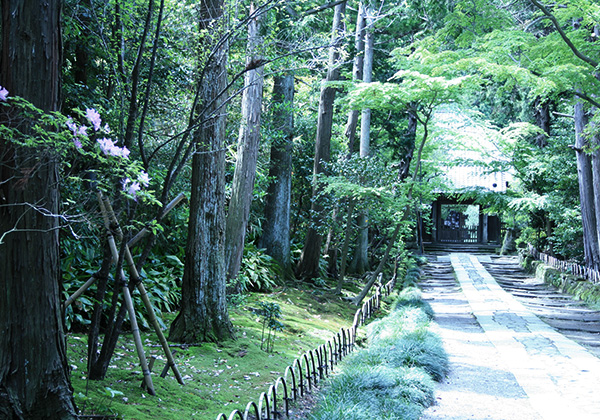Jufukuji
| Official Name | Kikokuzan Jufuku-kongo Zenji {Pronounced key-kok-zan jew-hook kongo-zen-gee} |
|---|---|
| Religious sect | Kenchoji School, Rinzai (Zen) Sect, Buddhism |
| Founded | in 1200 by Masako Hojo {mah-sah-ko hoh-joe} |
| Founding priest | Eisai Myo-an {a-sigh myo-an} |
| Main object of worship | Statues of Shaka Nyorai {shah-kah nyo-rye} trinity |
| Address | 17-7 Ogigayatsu 1-chome, Kamakura, Kanagawa 248-0011 (show route from current location ) |
| Location | 500 meters north of Kamakura Station |
| Time needed to get there | 10 minutes |
| Open | No visit to the precincts of the temple is allowed. |
| Phone number | 0467-22-6607 |
| Restrooms | Available near the First Gate |
Historical Overview
The Temple had been built almost half-a-century earlier than Kenchoji, which is generally regarded as the first Zen temple in Kamakura, and yet the Temple ranks third on the list of the Five Great Zen Temples in Kamakura, as it did not employ the Zen tenet in the first place. Masako Hojo (1157-1225) erected the Temple to propitiate the soul of the departed husband, Yoritomo Minamoto {yo-re-toh-moh me-nah-moh-toh} (1147-1199), the founder of the Kamakura Shogunate, following his unexpected demise in 1199. She chose this site where the residence of Yoshitomo {yo-she-toh-moh} Minamoto, Yoritomo's father, had existed. She invited Priest Eisai Myoan (1141-1215) as the founding priest, at a time he was not necessarily well accepted in Kyoto. Priest Eisai was born in Okayama Prefecture and took Buddhist vows at the age of 14. First, he studied Tendai sect Buddhism in Enryakuji {en-ryak-gee} near Kyoto, the mecca of the sect in Japan. He visited China twice, in 1168 and in 1178, to further study Buddhism and introduced Zen doctrines into Japan for the first time. Hence he is called the father of Japanese Zen Buddhism.
However, the Tendai sect was so powerful back then that his dogmas were not welcome in Kyoto. Masako and her family invited the unhappy priest to Kamakura and asked him to expound Buddhism and perform religious service for them. Soon afterward, he was appointed as the founding priest of the Temple. Though he is said to be the Japanese pioneer of Zen, the doctrine he introduced in Kamakura was mixed with Tendai, Shingon and Zen creeds, mostly focusing on incantations and prayers. But, he was so influential in preaching Zen that in later years a number of talented Zen priests were brought up. Just to name a few, Gyoyu Taiko {gyo-yoo tye-koh} (1163-1241), the second chief priest of the Temple and the founding priest of Jomyoji, Doryu Rankei {doh-ryu ran-kay} (1213-1278), the founding priest of Kenchoji, and Shonen Taikyu {sho-nen tye-kyu} (1215-1289), the founding priest of Jochiji, were disciples of Priest Eisai, all were notable and excellent Zen priests. In the latter half of the 12th century, Jufukuji was expanded into a full-fledged Zen temple.
Priest Eisai was also famous for his introduction of green tea into Japan and brought its seedlings from China. They were planted at Uji {woo-gee}, south of Kyoto, and Uji later became a production center of Japanese green tea. When Sanetomo {sah-neh-toh-moh} Minamoto (1192-1219), the second son of Masako and the Third Shogun of Kamakura Shogunate, was suffering from a hangover one day, he recommended to drink green tea, and addressed its medical efficacy in his two-volume essay entitled "Healing Sickness with Green Tea". Not only was this essay worthwhile for medical care, but also valuable as an ancient writing, and it is on the list of Important Cultural Assets. Medical value of green tea is proved by today's scientific technology. A Swedish scientist recently found that a substance in green tea called epigallocatechin-3-gallate, or EGCG, can prevent the growth of new blood vessels in cancer cells.
In the meantime, Sanetomo repaired to the Temple and often listened to the preaching of Priest Eisai and his disciples. In its golden days, the Temple had as many as 14 sub-temples, and on the occasion that the mass requiem for the 12th anniversary of Ninth Hojo Regent Sadatoki Hojo's death took place at Engakuji in 1323, says the record, 260 priest participated from the Temple. Unfortunately, the main hall is not open to the public. Visitors can get access only up to the inner gate.
In the neighborhood of the Temple, there lived many sculptors of Buddha statues such as the Goto {go-toh}, Mitsuhashi {me-tsu-hah-she} and Kano {kah-noh} families, and they contributed to the development of wood-carving technique. Many of the statues were carved by those family members. As the year progressed and culture in Kamakura declined, however, Buddha statues were no longer in demand. They gradually switched object of wood-carving from Buddha statues to others using the technique they so long inherited from their ancestors, and it eventually produced today's Kamakura lacquered wood-carving called Kamakura Bori {bo-re}.
Meanwhile, the Temple is designated as a Historic Spot by the National Government.
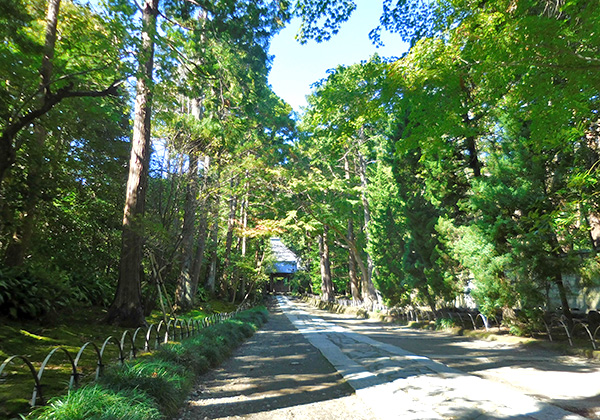
Main Hall
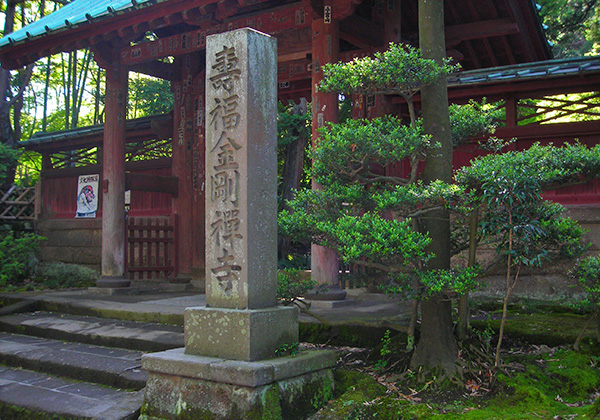
The building was destroyed by fires many times and the current one was rebuilt during 1751 to 1763. Inside the hall, a trinity statues of Shaka or Sakyamuni in Sanskrit flanked by two attendants are enshrined as the main objects of worship. The statue of crowned Shaka here is popularly called Kago {kah-go} (basket) Shaka named after the way it was produced. First, a wooden frame for a statue is made, on which a rough figure of statue is modeled with clay. Then, hemp cloths are affixed to it with lacquer to form multiple layers. After it is dried up, the clay inside the statue is taken out. With elaborate paintings on the surface, the work is completed, which sounds like a cage. Hence, the name of Kago Shaka. By whom and when it was made are unknown. Some say it was in 1395. Flanking the Shaka statue are those of Fugen Bosatsu {foo-ghen bo-sah-tsu} or Samantabhadra in Skt. in his right and Monju Bosatsu {mon-jew bo-sah-tsu} or Manjusri Bodhisattva in Skt. in his left. All are 295 centimeters tall.
The hall has also a statue of Eleven-Headed Kan'non or Ekadasamukha in Skt. and it ranks 24th among the Thirty-Three Kamakura Kan'non Pilgrimage.
In addition, the following statues are enshrined:
Deva Kings: Brought from Tsurugaoka Hachimangu Shrine shortly after the Meiji Imperial Restoration of 1868. The new government ordered to separate Buddhist elements from Shinto shrines. A pair of gigantic statues.
Priest Eisai: Sitting on a chair, Pries Eisai wears priest's robes which drape down, a typical Sung style. Characteristic is it's squarish head and it is called Eisai Gashira {gah-she-rah} (head). Made of wood during the Kamakura Period (1185-1333), and 96.4 centimeters tall, it is an ICA designated by the Prefectural Government. The Temple has two statues of Priest Eisai and the other is kept at the Kamakura Museum.
Daruma {dah-roo-mah} or Bodhidharma in Skt. Bodhidharma is a Chinese Zen Buddhist in the 6th century and well respected in Japan as the founder of the Zen Buddhism. Believed to be made in the 14th century, it is 95 centimeters tall.
Jushin Joshin {jew-shin joe-shin}, made in 1376. A famous Chinese Zen Buddhist, Joshin lived in Hebei Province.
Other than the above, the Temple owns a statue of Jizo {gee-zoh} Bosatsu or Ksitigarbha-bodhisattva, an ICA, made in the later half of the Kamakura Period, but it is kept by the Kamakura Museum and on regular display. The statue is unique in that the entire body including pedestal is made of a single-wood block.
Another important statue owned by the Temple but kept at the Kamakura Museum is a statue of Indian Priest Kasho or Kasyapa in Skt., one of the Ten Great Disciples of Sakyamuni and is most respected by Zen Buddhists. Priest Kasho is known of his contribution to making scriptures of Buddha's teachings.
To the right of the main hall building are caves called Yagura {yah-goo-rah}, in which ashes of all the chief priests are buried. Jufukuji was also the family temple for local sculptors of Buddha-statues who lived near here as noted above, and their ashes were also buried in yagura here.
